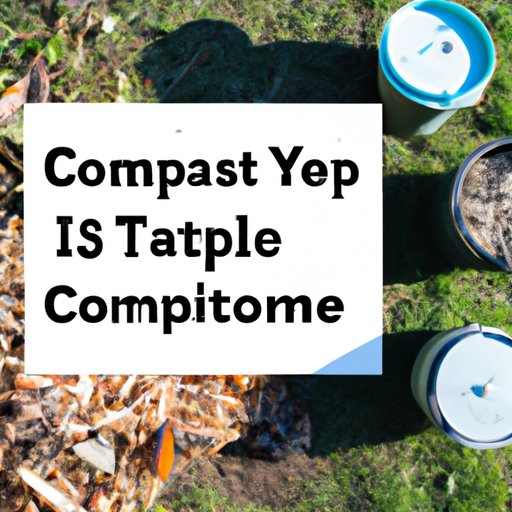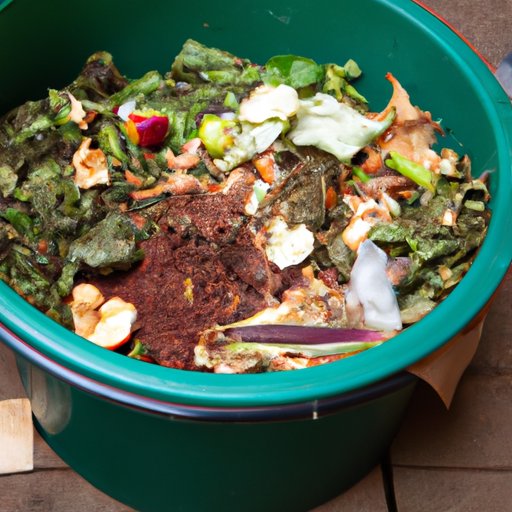Introduction
Composting has become increasingly popular in recent years as people seek out more sustainable ways to live. It’s a simple and effective way to turn food scraps and yard waste into nutrient-rich soil that can be used for gardening and landscaping. In this article, we’ll provide a step-by-step guide on how to compost effectively so that beginners can get started with confidence.
Composting offers numerous environmental benefits, including reducing waste and carbon emissions. Composting also improves soil health, which can lead to healthier plants and a more bountiful garden. Let’s dive in and explore how to compost!
The Basics of Composting: A Step by Step Guide for Beginners
Composting is essentially the process of breaking down organic materials into a nutrient-rich soil amendment. The key ingredients for successful composting are nitrogen-rich “green” materials (like food scraps and grass clippings), carbon-rich “brown” materials (like leaves and wood chips), water, and air.
To get started with composting, follow these steps:
- Choose a spot: Find a convenient location for your compost pile, preferably in an area that receives partial sunlight and has good drainage.
- Add brown material: Begin by adding a layer of brown material to the bottom of your compost bin, followed by a layer of green material.
- Add water: Add enough water to dampen the pile, but not too much that it becomes saturated.
- Mix it up: Use a pitchfork or shovel to mix the materials together. This introduces air and helps create pockets for the beneficial microbes to thrive.
- Repeat: Continue adding layers of brown and green material, watering as needed, and mixing the pile regularly.
- Get some air: Turn your compost pile regularly to add oxygen and allow the microbes to continue breaking down the materials.
- Patience is key: Composting takes time. Depending on your materials and climate, it can take anywhere from a few months to a year for your compost pile to turn into rich soils.
It’s important to note that there are some materials that should not be added to the compost pile, including meat, dairy, pet waste, and diseased plants. These materials can attract pests, produce foul odors, and transmit pathogens.
If your compost pile is producing unpleasant odors or taking too long to decompose, there are some troubleshooting tactics you can try. For example, adding more brown material (like dry leaves) can help balance the moisture levels. Incorporating a compost accelerator (such as urine or a commercial product) can help speed up the decomposition process.

5 Simple Ways to Start Composting in Your Backyard
If you’re new to composting, it may seem overwhelming to get started. Fortunately, there are plenty of simple and easy ways to start composting at home.
One of the easiest methods is to simply start a compost pile in your yard. All you need is a designated area and a willingness to collect and add the right materials. You can also purchase or build a compost bin or use a compost tumbler for a more contained and efficient method.
If you’re short on space, consider using a different method, like setting up an indoor worm compost bin or using a balcony composter. In any case, the basic principles of composting apply: balance brown and green materials, maintain the proper moisture levels, and turn the pile regularly.
How to Choose the Right Composting Method for Your Home
Choosing the right composting method depends on a few factors, including your available space, the climate you live in, and how much waste you generate.
Some common composting methods include vermicomposting (using worms to break down materials), grasscycling (using grass clippings to fertilize your lawn), and using a pre-made composter. Consider the pros and cons of each method and try a few to see what works best for your home.
To help make the decision easier, we’ve created a checklist to help you determine the best composting method for your needs:
- Do you have a yard or garden? If so, how much space do you have for a compost pile?
- How much organic material do you generate on a regular basis?
- What is the climate like in your area? Is it hot, dry, or prone to heavy rainfall?
- Do you want to recycle food scraps, yard waste, or both?
- Do you want to purchase a pre-made compost bin or build one yourself?
DIY Composting Bin: A Guide to Building Your Own
If you’re interested in building your own composting bin, it’s actually quite simple. All you need is some basic materials and a few hours of time. Here’s how to do it:
- Gather your materials: You’ll need wire mesh (like chicken wire), wooden stakes, a hammer, and wire cutters.
- Create a frame: Use the stakes to create a square-shaped frame, then wrap the wire mesh around the frame and secure it with wire cutters.
- Add a door: Cut a section of the wire mesh out and fold it back to create a door. Secure it with wire cutters.
- Place the bin: Choose a location and place the bin, making sure it’s in a spot that’s convenient for adding and turning compost.
- Add your materials: Start filling the bin with a mix of brown and green materials, adding water as needed to maintain the moisture levels.
- Maintain the bin: Mix the compost regularly, turning it with a pitchfork or shovel to introduce air and speed up the decomposition process.
There are plenty of ways to customize your compost bin to suit your needs. For example, you can add wheels to make it easy to move, or add a lid to keep pests out.
7 Common Composting Mistakes You Should Avoid
Like anything else, composting involves a learning curve. Mistakes happen, but it’s important to identify and correct them in order to achieve the best results. Here are some common composting mistakes to avoid:
- Using too many food scraps
- Not turning the pile frequently enough
- Adding materials that don’t belong (like meat or dairy products)
- Not enough balance of brown and green materials
- Letting the pile get too wet or too dry
- Not providing enough air or ventilation
- Not being patient enough – composting takes time!
Fortunately, most composting mistakes can be corrected. If you find that your pile is too wet, add more brown materials. If it’s too dry, add some water. Turning the pile regularly can also help introduce air and speed up the decomposition process.
Composting for Urban Dwellers: Tips for Small Spaces
Even if you don’t have a backyard, there are plenty of ways to compost in small spaces. For example, you can use an indoor worm bin, which takes up very little space and is easy to maintain. You can also use a balcony composter, which can be placed on your balcony and used to compost food scraps and other organic materials.
There are a few special considerations when composting in urban environments. For example, you’ll need to be careful not to attract pests (like raccoons or rodents) by properly covering and securing your compost bin. You’ll also need to be aware of the temperature and moisture levels in your environment, as they can affect the composting process.
From Scraps to Soil: How Composting Benefits the Environment and Your Garden
Composting offers numerous benefits, both for the environment and your yard or garden. Here are a few ways that composting can make a positive impact:
- Reduces waste: By composting your food scraps and yard waste, you’re diverting material from the landfill and helping to reduce waste.
- Improves soil health: Compost is a nutrient-rich soil amendment that can help improve soil structure, retain moisture, and promote healthy plant growth.
- Reduces carbon emissions: When organic materials decompose in a landfill, they produce methane gas, which is a potent greenhouse gas. Composting helps reduce these emissions.
Using compost in your garden can also help improve plant growth, increase yields, and reduce the need for synthetic fertilizers. To use compost in your garden, simply work it into your soil before planting or use it as a top dressing around existing plants. You can test your soil pH to determine how much compost you need to apply.
Conclusion
Composting is a simple but effective way to reduce waste, improve soil health, and promote a more sustainable lifestyle. By following the basic principles of composting and avoiding common mistakes, anyone can become a successful composter. Whether you have a large backyard or a small balcony, there are plenty of options for composting that can work for your lifestyle. Consider building your own compost bin, starting a worm bin, or simply setting up a compost pile in your yard.
